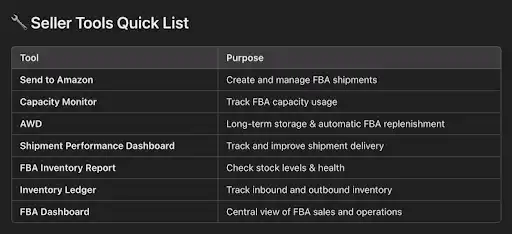Prime Day 2024 was a record-breaker, with over 200 million items sold by independent sellers in just 48 hours. For 2025, Amazon is going even bigger—this year’s Prime Day will be a 4-day event, giving brands more visibility, more time to convert shoppers, and more opportunity to win.
This guide combines all key updates and readiness strategies in one place to help you prepare effectively for this extended event.
Key Prime Day 2025 Deadlines
These dates will shape your Prime Day strategy. Set internal reminders now.
- March 18, 2025 – Deal scheduling opens (Prime-Exclusive Best Deals and Lightning Deals)
- May 5, 2025 – Prime-Exclusive Price Discount submissions open
- May 23, 2025 – Deadline to schedule Best Deals and Lightning Deals
- June 9, 2025 – FBA shipment deadline (Minimal Shipment Splits)
- June 18, 2025 – FBA shipment deadline (Amazon-Optimized Shipment Splits)
If you’re using Amazon Partnered Carriers, your inventory should be ready for pickup at least 14 days before the deadlines.

Prime Day Promotions: What You Can Offer
- Prime-Exclusive Best Deals
- Duration: All 4 days
- Discount: Minimum 15%
- Fee: $1,000
- Visibility: Amazon Deals page, homepage features, badges in search and product pages
- Best for: Top-performing, high-converting ASINs
- Prime-Exclusive Lightning Deals
- Duration: Up to 12 hours
- Discount: Minimum 20%
- Fee: $500
- Visibility: Amazon Deals page, badges, product pages
- Best for: Creating urgency, boosting velocity, clearing inventory
- Prime-Exclusive Price Discounts
- Discount: Minimum 15%
- Fee: $100 (covers up to 500 SKUs)
- Visibility: Search results, product page, and cart (no placement on Deals page)
- Best for: Broad national promotions without needing to meet Lightning/Best Deal criteria
- Prime Member Coupons
- Discount: Minimum 5%
- Fee: $5 per coupon + 2.5% of coupon redemptions
- Visibility: Coupons page, search results, and product detail pages
- Best for: Flexible discounting on specific ASINs or bundles
How to Prepare for Prime Day 2025: A Step-by-Step Checklist
Step 1: Strategize Early Based on Data
- Analyze last year’s Prime Day performance: Which SKUs converted? What pricing worked?
- Use business reports, search term reports, and advertising data to identify high-potential products.
- Look for any seasonality or trends that might affect this year’s demand.
Step 2: Select and Submit Deals
- Use your Deals Dashboard to identify eligible ASINs.
- Submit Best Deals and Lightning Deals before May 23.
- Use pricing rules to ensure margins still work after deal fees and discounts.
- For ASINs that aren’t eligible for those promotions, consider using Prime-Exclusive Price Discounts or Coupons.
Step 3: Optimize Product Listings
- Ensure titles, bullets, and descriptions are clean, compelling, and keyword-rich.
- Upload high-resolution images that comply with Amazon’s requirements (no text, watermarks, or logos).
- Add A+ Content and Brand Story if available to strengthen brand recall and conversion.
Step 4: Lock in Inventory Early
- Finalize your inventory forecast based on previous Prime Day and Q2 sales patterns.
- Plan for 4+ weeks of buffer stock across fast-moving SKUs.
- Use Capacity Monitor to check fulfillment limits.
- Consider Amazon Warehousing & Distribution (AWD) for bulk storage and auto-replenishment without impacting your FBA capacity.
Step 5: Ship Smart, Avoid Delays
- Choose between Minimal Shipment Splits (June 9) or Amazon-Optimized Shipment Splits (June 18).
- Provide accurate box content info using Send to Amazon or Amazon Marketplace Web Service to avoid delays.
- Book shipments early with Amazon Partnered Carriers or Amazon Freight.
- Monitor the Shipment Performance Dashboard for delays or defects.
Step 6: Prepare Your Ad Strategy
- Increase budgets on high-performing campaigns starting a week before Prime Day.
- Create dedicated campaigns for deal ASINs, separating them from regular ads.
- Target competitors’ ASINs, relevant category keywords, and branded search terms.
- Leverage Sponsored Brands and Sponsored Display for wider reach.
Step 7: Promote Outside of Amazon
- Send out teaser emails and Prime Day-specific campaigns to your existing customer base.
- Use Instagram, Facebook, and TikTok to build anticipation and drive traffic to your deals.
- Highlight urgency and exclusivity—limited-time Prime Day savings are only available to members.

Inventory Management Tools That Can Help
- Capacity Monitor: View and manage fulfillment center capacity limits.
- Capacity Manager: Request extra space and earn back reservation fees through sales.
- AWD (Amazon Warehousing and Distribution): Long-term storage + automated FBA replenishment.
- Minimum Inventory Level Tool: Get restock recommendations for each ASIN.
- Send to Amazon: Streamlined shipment creation.
- Box-Level Inventory Placement: Improve inventory distribution for small parcel shipments.
Final Recommendations
- Act quickly: Deal eligibility windows are already open, and slots fill fast.
- Submit early: The sooner your deals and shipments are locked in, the better the execution.
- Track everything: Use Seller Central tools daily in the lead-up to Prime Day.
- Think long-term: The lift you get from Prime Day can carry through Q3, especially for repeat-purchase products or replenishable items.






